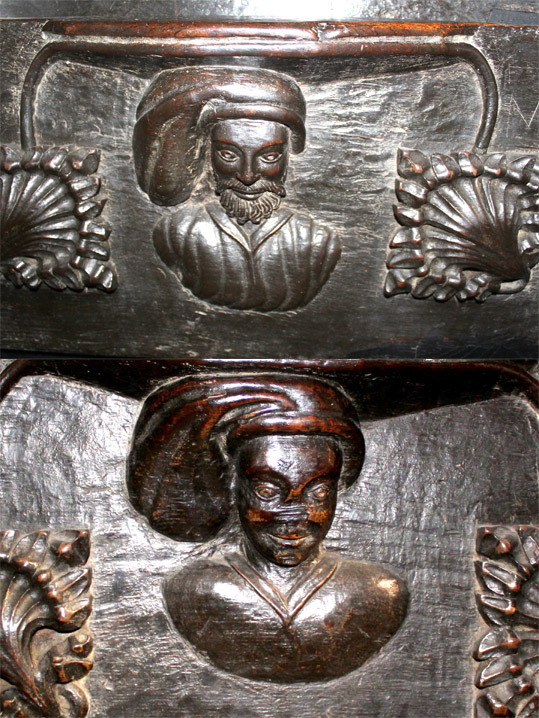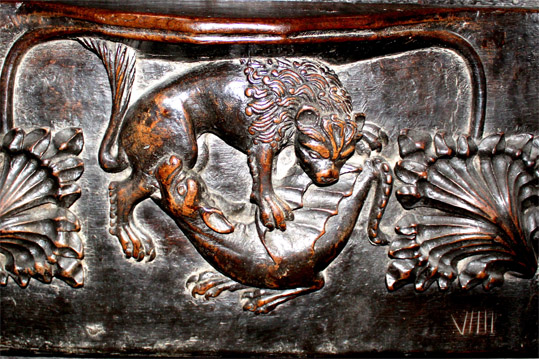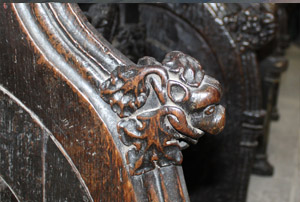POLITICS AND RELIGION IN THE FIFTEENTH-CENTURY CITY
Published in Features, Issue 4 (July/August 2022), Volume 30The misericords of St Mary’s Cathedral, Limerick.
By Charlotte Murphy
St Mary’s Church of Ireland cathedral in Limerick possesses the only set of medieval choir-stalls to survive Ireland’s troubled past. Attached to the underside of these stalls—or misericords, as they are more usually known—are fascinating carvings. There are also bosses of a grotesque nature at the ends of the armrests. Most writers dealing with the subject have dated the Limerick misericords to between 1480 and 1500. Maurice Lenihan, however, in his history of Limerick, published in 1866, is alone in suggesting that they were carved when Conor O’Dea occupied the see of Limerick from 1400 to 1426.
In the early fifteenth century the land of Ireland, outside the Pale, was slipping away from the control of Dublin and London. The cities remained faithfully English and loyal to the Crown but were themselves increasingly isolated and under attack. Limerick defined itself in terms of steadfast devotion to the monarch. This was its identity and it wished to state, for all the world to see, that its staunch support was for England’s ruler, whoever he happened to be.
DILEMMA
In 1399 Henry Bolingbroke usurped the throne of his cousin, Richard II. This presented the political classes of Limerick with a dilemma. Should they stay loyal to Richard or give their allegiance to the new king? The misericords in St Mary’s demonstrate clearly that the wealthy and powerful in the city decided to accept Henry. The head and shoulders of a man carved on one of the misericords (see below) is unmistakably a likeness of Henry IV. He is wearing a chaperon, a head-dress with flowing material which ends on his right shoulder. This form of headgear belonged to the late fourteenth/early fifteenth century. He also has a beard, as do other illustrations of Henry IV from this period. His successors over the following century, on the other hand, are all depicted as clean-shaven in their portraits in the National Portrait Gallery and the Victoria and Albert Museum, London.
There is one other representation of a human head and shoulders on a misericord (opposite page, bottom). It has been damaged but it is perfectly possible to see here a portrait of a young man, also wearing a chaperon. This is surely the young prince who became King Henry V when his father, Henry IV, died in 1413. Limerick’s loyalty was well rewarded by Henry V’s charter of the same year, which many historians believe converted Limerick from an autonomous urban area into a city state.
POLITICAL MESSAGES
In the medieval mind, the beast that symbolised evil and even the Devil himself was the wyvern. This is a form of dragon but with only two legs, whereas the dragon has four. On these misericords there are two carvings of a wyvern engaged in intense combat with a lion (second image below). The lion may represent Christ, the Lion of Judah, in conflict with the Devil, but a closer look at the politics of England and Wales during the reign of Henry IV can lead to another interpretation. After 1400 Wales rose in revolt against Henry. The leader of the uprising was Owain Glyn Dwr, Prince of Wales. One of Glyn Dwr’s surviving seals shows him in full armour on a prancing horse, and his helmet is topped by a red wyvern, his crest. It is not impossible to see the battle scene between the lion, representing the king, and the wyvern, representing Owain Glyn Dwr, as a symbolic rendering of this revolt in Wales. The two carvings, which are identical, show that the lion is dominant but still wounded. The fact that the battle scene is represented twice is evidence of the great importance it had in the minds of Limerick’s political leaders. It was a means of discouraging any ideas of revolt against the king; revolt leads to war and destruction.
Another carving that seems to convey a political message is that of a pair of unicorns with their necks intertwined. The unicorn appeared on the royal arms of Scotland from sometime in the medieval period. It seems probable that the beasts were again used as a warning against war and the dire consequences of rebellion. In 1400 King Henry IV made an attempt to invade Scotland in order to punish that kingdom for its constant attacks on England’s northern border. The fact that he was unsuccessful was not seen as relevant; what mattered was the lesson that disloyalty could lead to war and turmoil.
FEW REPRESENTATIONS OF THE HEAVENLY
The grotesques on the ends of the armrests remind all who see them of the importance of living a life that is pleasing to God. These little carvings depict the ugliness of sin. There is one with the repellent face of what could be a pig or a boar with some serpent-like creature in its mouth and moving around the side of its face. It may be a warning against the sin of gluttony or it may represent the ugliness of sin in general (bottom image).

The bearded figure wearing a chaperon (top) is unmistakably a likeness of King Henry IV (1399–1413), while the damaged figure (bottom) is surely his successor, Henry V (1413–22), who rewarded Limerick’s loyalty with a charter in 1413.
It may seem strange that a set of choir-stalls in a cathedral do not have any reference, apart from one representation of an angel, to the things of Heaven. This choice of secular themes was not confined to medieval Limerick. The same is true of surviving misericords in English churches. Exeter cathedral has the oldest examples of misericords in England, going back to 1220. They have carvings of lions and dragons fighting, and many examples of English foliage. Chester cathedral has carvings of St George fighting the dragon, griffins, husbands and wives in conflict, angels playing musical instruments and one carving which has been interpreted as a representation of the crowning of Our Lady in Heaven. If this interpretation is correct, it is probably the only instance in which representations of Christ and Our Lady are to be found on a misericord in an English church. The reason for this is not too difficult to understand. The misericords were erected to be sat upon; it seemed extremely disrespectful to use representations of Our Lord and Our Lady in this fashion.

Above: A lion and a wyvern engaged in combat, possibly representing the struggle between Henry IV and Owain Glyn Dwr, Prince of Wales, whose crest was a red wyvern.
Paul Hardwick has argued against the thesis put forward by Francis Bond in Wood carvings in English churches. Bond believed that the carvings on misericords represented folk art and did not see them as having any religious meaning. Hardwick, however, argued that the carvings were intended to carry messages which were, in the broadest sense, religious. They dealt with the fight between good and evil. There are many carvings of wyverns on misericords in Manchester cathedral, thus reminding people of the constant battle waged between good and evil, while the pelican feeding its young with its own blood was a reminder of Christ’s love for His people.
It is not so extraordinary, then, to find that the misericords in Limerick carry their own political message. Limerick was a city whose devotion to the Crown of England can be seen in the charter it received from King Henry VI in 1423:
‘… no one who is an Irishman, by blood and nation, shall be mayor, or exercise any office within our said city; nor shall anyone within the aforesaid city take or maintain any child of Irish blood and nation, as is aforesaid, as an apprentice, under penalty of forfeiting his franchise in the aforesaid city.

Above: One of the ‘grotesques’ that appear at the ends of armrests, representing perhaps gluttony and the ugliness of sin in general.
The Crown protected the city, and the city protected the Crown.
English misericords in general have a didactic function. They teach Christian morality, good versus evil. Therefore the use of the misericords in St Mary’s to fulfil the same function of teaching important lessons was not a strange or unusual departure in the fifteenth century. Grotesques on the ends of the armrests teach not politics but lessons on the Seven Deadly sins. All of the carvings are used as teaching aids, be they political or moral.
In her paper on the Limerick misericords, Christa Grossinger quotes from Gerald of Wales and Pope Honorius, who both condemn Ireland as being ‘isolated at the uttermost ends of the earth’. This sweeping political rather than geographical opinion could not, however, withstand scrutiny in the context of fifteenth-century Limerick. There are many references to the foreign trade in which Limerick engaged during those years. For example, in 1375 Davy Crewagh, mayor of Limerick, seized the Earl of Desmond’s wine, and both Portuguese and Breton ships were recorded in the harbour. John Hethe sent a cargo of wine, salt, honey and other merchandise, valued at 1,000 marks, in La Trinité to Limerick in 1401. Recent archaeological work in the city has shown imports from northern and south-western France and from the Bristol area in the high medieval period. In the late medieval period wares of German, Dutch, Spanish, Portuguese and Italian origins were found. Clearly, Limerick was not a backwater whose inhabitants were unaware of the great world outside. As we have seen, the city was very conscious of the powerful political movements taking place in England and it acted accordingly, in order to protect its own position.
Charlotte Murphy is an English and History teacher, with a Ph.D in History from UCC.
Further reading
F. Bond, Wood carvings in English churches (2 vols) (Oxford, 1910).
C. Grossinger, ‘At the uttermost ends of the earth’, in R.A. Stalley (ed.), Limerick and south-west Ireland: medieval art and architecture (Leeds, 2011), 243–52.
P. Hardwick, English medieval misericords: the margins of meaning (Woodbridge, 2011).
M. Lenihan, Limerick: its history and antiquities ecclesiastical, civil and military, from the earliest ages (Limerick, 1866).
















